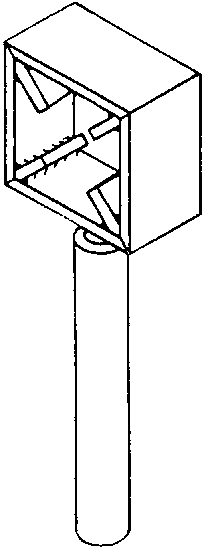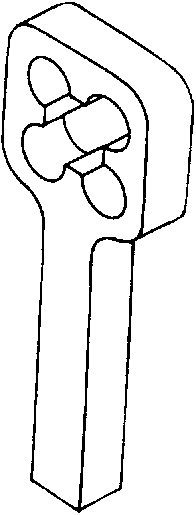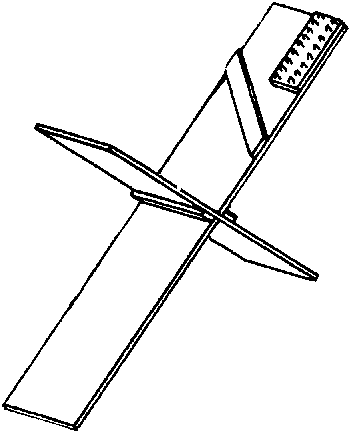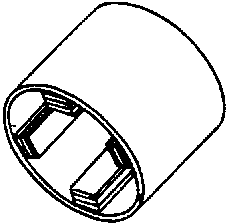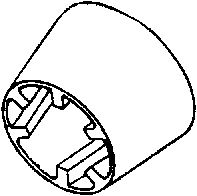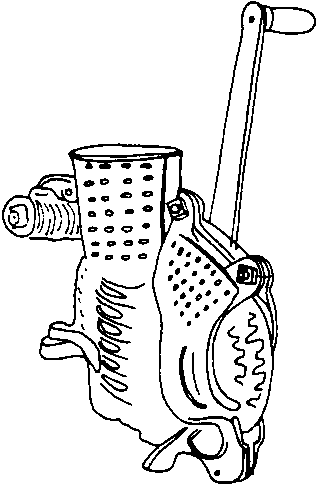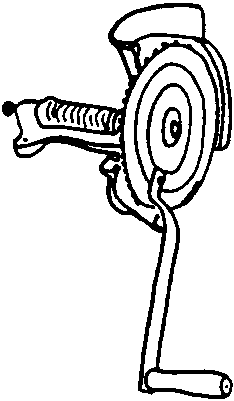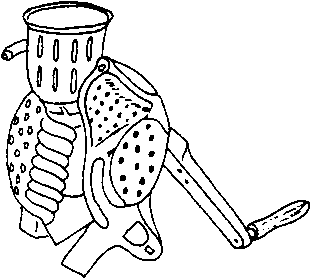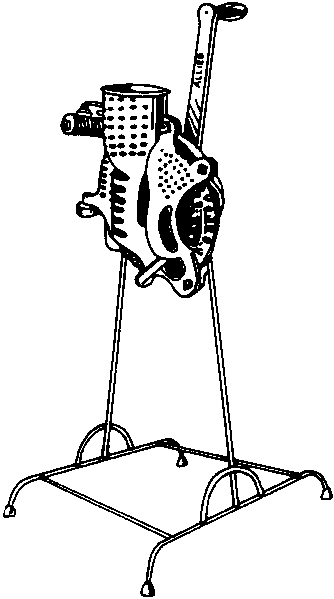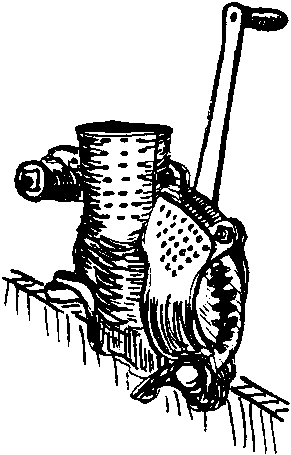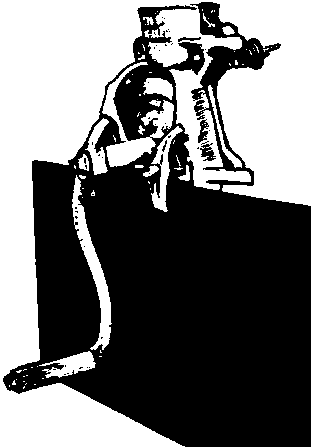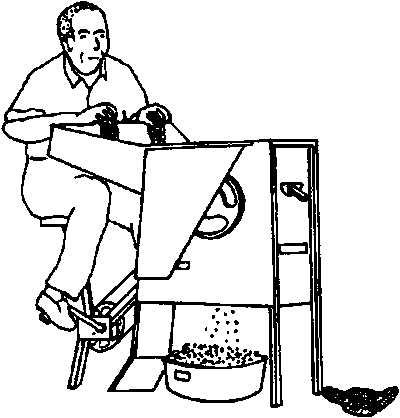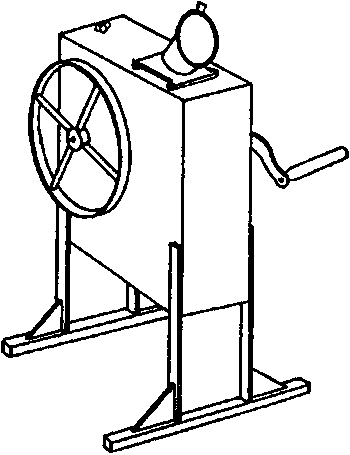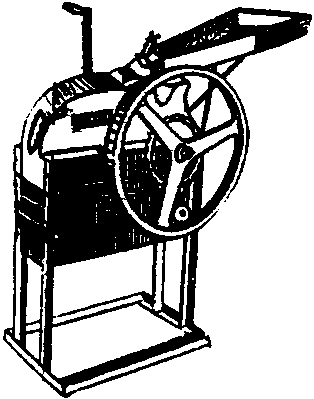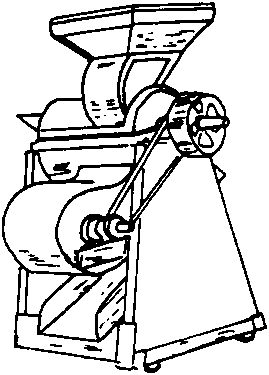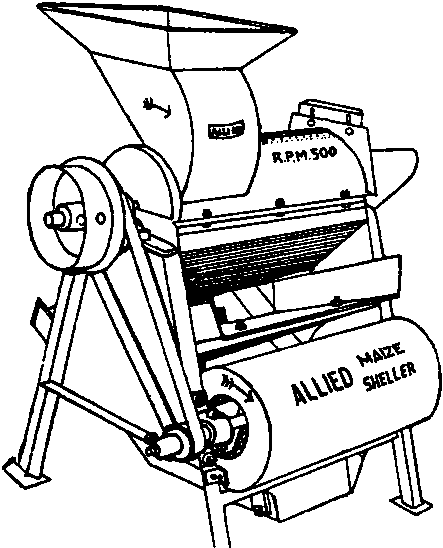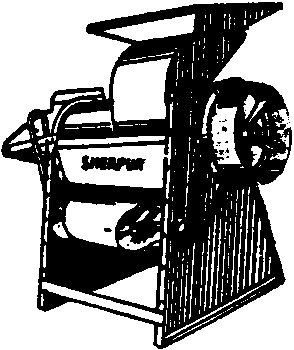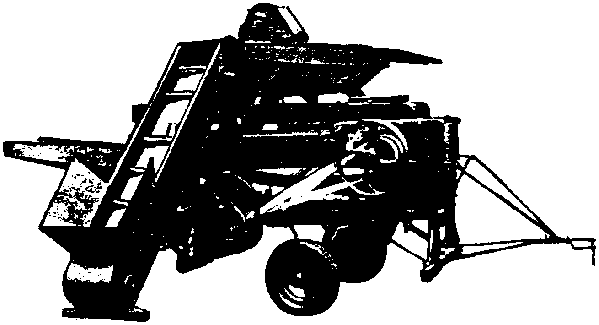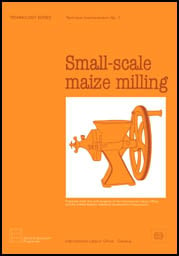
Small Scale Maize Milling (ILO - WEP, 1984, 160 p.)
CHAPTER III. SHELLING
I. GENERAL REVIEW OF SHELLING TECHNIQUES
I.1 Location of shelling
From a purely economic viewpoint, shelling should be carried out at or close to the maize-growing area, either as part of the harvesting operation (e.g. use of a suitably equipped combined harvester), or at a nearby production unit. The main reason for locating the shelling operation close to the growing area is the large difference in weight and volume between the unshelled cob and the shelled grain. Otherwise, the shelling of maize in mills located far away from the point of harvest will considerably increase transport costs. However, there are many occasions where maize is shelled outside the growing area. For example, a large-scale mill, located in an urban centre, may use its own shelling equipment in order to ensure a standard quality of grain (e.g. grain with an appropriate moisture content and free from moulds, contaminants, stones, etc.) and sufficient stocks of the raw material.
Depending on circumstances, and notwithstanding the points raised above, maize may be shelled at the following locations:
- in households, using manual methods;
- in custom mills;
- in small-scale merchant mills;
- in large-scale roller mills; and
- in the field, as part of the harvesting operation.
Since this memorandum is mostly concerned with small-scale milling technologies, this chapter will emphasise shelling techniques which are particularly suitable for custom and small-scale merchant mills. However, some information on shelling tools of particular interest to households will also be provided for the benefit of local manufacturers who may promote these tools among rural households.
I.2 General review of shelling techniques
Maize shelling techniques may include the use of the following devices:
- hand-held devices of various designs and outputs;
- small rotary hand shellers;
- free-standing hand shellers;
- small powered/large hand-operated shellers with cleaning and grading facilities; and
- large powered shellers with loading, cleaning, grading and bagging facilities.
Some shellers used in large-scale roller mills may also incorporate a husking mechanism. Outputs from the above shelling devices range from 15 kg per hour for hand-held devices to over four tonnes per hour for large-scale shellers.
I.2.1 Effect of grain moisture content
The shelling of maize grain is extremely difficult to undertake at moisture contents above 25 per cent, and may not be carried out efficiently at moisture contents between 17 and 25 per cent. Shelling maize at these high moisture contents results in high mechanical grain damage, reduced grain stripping efficiency and high power consumption. In general, efficient shelling is best undertaken after the grain has been suitably dried to a moisture content of 13 to 14 per cent. On the other hand, the use of combine harvesters, for the shelling of maize in the field before it is sufficiently dried, can result in high damage rates of the grain of up to 20 per cent (Waelti and Buckle, 1967).
I.2.2 Shelling damage
Appropriately dried maize may still be damaged during shelling (e.g. a fraction of the grain may get surface scratches or break). Such damage will be of little consequence if the maize is to be further processed shortly after shelling (e.g. it may be milled or cooked). On the other hand, shelled maize which must be stored over a long period will deteriorate as a result of attacks by secondary pests or fungal invasion which spread through the damaged surface of the grain. This deterioration will happen even if the grain is sufficiently dry and properly stored.
The extent of shelling damage depends on the shelling technique, the skill of the operator, and the type of maize being shelled. In general, manual shelling methods - with exception of those involving scrapping and beating - and efficient small shellers result in much less grain damage than do large, powered shellers. However, many farmers or mill operators do not use these small shellers efficiently and do produce a high fraction of damaged grain for the following reason. A number of rotary hand shellers are equipped with an adjustable spring which allows an increase in the pressure on the cob in order to improve the shelling action. Since most farmers cannot tolerate the loss of unstripped grain nor the extra effort required to recover it by hand, they tend to adjust the spring to a high pressure setting in order to ensure a complete stripping of the cob. Such a high pressure results in extensive damage of the grain surface, and in the loss of grain if the latter is to be stored over a long period of time.
I.2.3 Factors affecting the choice of shelling technique
Depending on the scale of production, one or more shellers may produce the required output of shelled maize. The most appropriate shelling technique will thus be the one which minimises production costs per unit of output for a given loss rate of damaged grain, quality of output (e.g. extent to which the shelled grain is free from sand, stones, dead pests, etc.) and the quality of raw materials (e.g. moisture content, size and quality of the cobs, the relative softness of the grain endosperm).
When comparing two alternative shelling techniques, one must take into consideration all ancillary operations since some shellers may carry out some or all of these, while other shellers may only carry out the shelling operation. Thus, such a comparison should take into consideration the cost associated with the following ancillary operations:
- removal of leaf sheaths;
- cleaning;
- sieving; and
- bagging, whenever required.
For a given quality of raw materials, the shelling cost must therefore include the following cost items:
- husking costs;
- cleaning and sieving costs;
- bagging costs;
- loss of revenues due to the presence of damaged grain in case the shelled maize must be stored (i.e., the sale of damaged grain is lower than that of grain in good condition).
The methodology for estimating these cost items with a view to selecting the most appropriate shelling technique is described in Chapter VI.
The choice of shelling technique should take into consideration the following variables:
(i) the total volume of crop to be processed;
(ii) the effective length of the shelling season and of the working day;
(iii) the actual capacity of available manual and engine-powered equipment;
(iv) the equipment and labour productivity; and
(v) the cost of the factors of production, including equipment costs, wages, interest rate, energy cost, etc.
Variables (i) and (ii) determine, for a given location, the minimum daily volume of maize which must be processed. The longer the length of the shelling season, and/or the larger the storage capacity, the lower will be the minimum daily volume. Variable (iii) and (iv) determine the number of each type of maize shellers for the processing of this minimum daily volume, taking into consideration the fact that some of the shellers are not equipped for the carrying out of ancillary operations. Finally, given the number of each type of shellers, and the labour, infrastructure and energy requirements for each type, the variables under (v) determine the unit production cost associated with each shelling technique.
It may be noted that the installed capacity of the shelling equipment may be affected by the following factors:
- the availability of sufficiently skilled labour and the organisation of the shelling operation as a whole;
- the level of moisture in the crop;
- the size and quality of the cobs;
- the extent to which dehusking is required of the machine; and
- the rate of supply of cobs.
The estimated capacity is often lower than the actual capacity, the difference between the two being generally larger for large-scale equipment than for small-scale equipment. One reason for this larger difference is that it is more difficult and time-consuming to maintain and repair large shellers than small shellers, especially the manual type shellers.
II. SHELLING EQUIPMENT
There are various types of shelling equipment, each type catering to differing scales of production and conditions (e.g. domestic use, co-ownership by small farmers, use by independent farmers on a daily hire basis, ownership by custom or merchant mills). Farmers often use small, hand-cranked, rotary shellers which are usually simple, effective, inexpensive and fairly durable. They are available from many manufacturers from both developing and industrialised countries. A priori, any developing country should be able to manufacture this type of shellers. The latter are of various designs, and made from a small number of iron castings. They utilise a spiked disk to prise out the grain while the cob is held by an adjustable spring-loaded pressure plate. While the capacities of different machines vary, these will at least double the rate of the most productive hand-held devices (e.g. 100 kg of grain per hour).
The larger, free-standing shellers are more productive and convenient, but more expensive. They are often fitted with cleaning and separation devices for the removal of unwanted material. The relatively large size of the maize grain facilitates the use of both cleaning fans for the blowing away of dust and light particles, and of simple reciprocating sieves for the removal of sand, stripped cob centres and broken or undersized grain. Depending on the type of sheller and on the number of operators employed, the capacity of these machines can be four times larger than that of the smaller rotary shelters. This may be explained by the use of low-friction bearings and of simple gearing which result in steady and high operating speeds. The shelling principles are similar to those of the smaller shellers. One main difference is the replacement of the spring-loaded pressure plate by a relatively low speed feed roller which forces cobs into the shelling element. The design and sizing of large shellers allow the use of alternative drive methods, such as small electric or petrol motors. These shellers are suitable for small-scale merchant mills.
The full-sized, diesel or electrically-powered shelling machines, with capacities of several tonnes per hour, represent the normal equipment used in large-scale, fully mechanised situations. A large number of firms produce their own designs for sale through normal agricultural equipment suppliers. No standardised design exists, but most shellers use broadly similar operating principles. These shelling machines are available in a variety of installations. Use within a mill requires a fixed installation, with associated handling and feeding facilities fitted close by. Mobile installations are also available. They are either wheeled or mounted on tractors. The high rates of throughput require the use of cob loading elevators and bagging equipment. Most shellers utilise a pegged drum, mounted on a horizontal shaft, which rotates at about 700-1,000 rpm. A concave metal screen, with holes approximating to the size of the grain, is located around the drum. It contains the cobs while shelling takes place. A baffle plate restricts the flow of he cobs, and maintains the required shelling pressure. A strong fan discharges the stripped cob centres and other large debris. A second, smaller fan is often used at the grain discharge point for the removal of the remaining dust and finer particles. Available information indicates that an average shelled grain output of 900 kg/hr/installed kWh may be obtained from these shellers.
Dehusking of the cob may be carried out with a special device installed within the shelling machine. The usual method of dehusking is to provide sets of contra-rotating rollers whose projections pull the husk away from the cob. It is possible to shell and husk maize, despite some loss of capacity, within the shelling section itself. However, it is recommended to obtain the advice of individual manufacturers on the practicability of this approach.
The working lifetime of the various components of these machines should be relatively high since no wearing or rubbing parts are employed. Thus, the need for spare parts, such as bearings, drum parts and screws should be relatively low. However, differences in materials of construction do occur and no typical replacement rates can be quoted. No skilled labour is required to run these machines since it is only necessary to manually feed the cobs and dispose of the grain and cob centres. The number of labourers employed has a pronounced influence on the work rate of the machines, particularly that of the smaller units with unmechanised loading.
II.1 Hand-held shelling devices
A number of hand-held devices have been developed with a view to improving labour productivity, reducing the tedium of work and minimising finger soreness. The hourly output of shelled grain achieved by these devices ranges from 8 kg to 15 kg per hour. Figure III.1 shows a number of hand-held devices developed in recent years. Table III.1 provides information on the designers/producers of these devices, the main construction method and skill requirements, their relative production cost and the estimated hourly output. It may be noted that all of these devices may be produced by local workshops using imported or locally available materials.
II.2 Small rotary hand shellers
These shellers are particularly suitable for small-scale production. They are effective and usually quite robust. Their operation is fairly simple, although grain damage may result from inadequate adjustment of the equipment. The turning of the handle forces the cob to rotate against the spikes of a disc which removes the grain. Available designs allow for the separation of the spent cob centre from the grain. This, however, requires that the owner improvise a mounting stand and grain collection facility. Designs from various manufacturers differ in surface finish, quality of alignment and material, and in the thickness of metal. These variations result in different outputs ranging from 14 to over 100 kg per hour. Whilst these shellers are best made in metal, it is possible to produce similar equipment from wooden constructions. They may be manufactured locally by skilled craftsmen and entrepreneurs.
Characteristics of hand-held shelling devices
|
Sheller type |
Source |
Description |
Construction |
Construction skill required |
Relative cost (local manufact.) |
Capacity kg/hr |
|
Decker |
See manufacturers list |
See illustr. |
15 | |||
|
Morogoro |
Prof. A.S. Ramo, University of Dar-es-Salaam, “Appropriate Technology”, Vol. 2, No. 1, May 1975 |
See illustr. |
Using saw timber |
Fairly high |
High |
13 |
|
Ceneema |
Bloc-notes du monde rural, No. 13, June 1977, B.P. 790, Yaound� (Cameroon) |
See illustr. |
Welded construction |
Fairly high |
Medium |
10 |
|
TPI |
Rural Technology Guide No. 1, 1977, Tropical Products Institute, London |
See illustr. |
Wooden carving |
Low |
Low |
10 |
|
PVC Pipe |
Dr. D.J. Hilton, University of Nairobi, Appropriate Technology Vol. 3, No. 2, Aug. 1976 |
See illustr. |
Glued PVC piping |
Low |
Low |
8 |
|
SATA |
Swiss Association for Technical Assistance, P.O. Box 113, Kathmandu, Nepal |
As Decker |
Folded sheet |
Fairly high |
Medium |
As Decker |
Figure III.1
HAND-HELD SHELLING DEVICES
Manufacturers from both developing and industrialised countries produce a large range of rotary hand shelters. Some of these may be adjusted for different sizes of cobs, and can be mounted on various frames. Plates III.1 to III.6 provide a brief description of some of these shelters for illustrative purposes. The quoted prices of some of the shellers are purely indicative. The reader may also wish to obtain information on other shellers from manufacturers mentioned in Appendix I.
II.3 Free-standing hand shellers
The free-standing hand shellers are relatively large and complete shelling machines. They are substantially more expensive than the smaller rotary shellers, but much more productive and easier to operate. The method of grain removal is similar to that for the small shellers, but includes some modifications to improve the capacity of the machine, (e.g. use of a flywheel and of mechanical cob feed rolls). These shellers are invariably fitted with a simple grain cleaning screen or winnowing fan, and have a positive separation of grain and spent-cob. They may be operated in a variety of ways for capacities ranging from 40 kg/hr (single hand operation) to 300 kg/hr (using a small motor and two operators). The design of these shellers varies from one manufacturer to another.
These shellers are particularly suitable for small-scale merchant mills. Plates III.7 to III.9 show two types of free standing shellers.
II.4 Large powered shellers
General information on large powered shellers has already been provided earlier in this chapter. No further technical details are provided in this section since these shellers are not generally suitable for small-scale shelling. Plates III.10 to III.13 describe some of these shellers manufactured in both developing and industrialised countries.
Produced by: UBUNGO FARM IMPLEMENTS
P.O. Box 2669
DAR ES SALAAM (Tanzania)Source: ITDG (1976)
Plate III.2 Hand maize shelter
Body and base-plate painted cast iron. Steel crank with wood handle. Moveable toothed plate on steel shaft with compressing spring (self-adjustable according to the size of the corn cobs).
Weight: 6 kg
Fixing base plate drilled with 4 holes.
Hourly output: up to 500 cobs
Produced by: RENSON ET CIE
B.P. 14,
59550 LANDRECIES
(France)Source: ITDG (1976)
Plate III.3 Hand maize sheller
A small machine which can be easily fitted to any wooden box. Maize cobs are fed into the cup-shaped opening and shelled as the handle is turned.
Produced by: DANDEKAR BROTHERS
(Engineers and Founders)
Sangli,
Maharashtra (India)Source: ITDG (1976)
Plate III.4 Allied maize sheller
The pressure plate, loaded by an adjustable coil spring, presses the cobs firmly against the toothed shelling plate and thus separates the kernels from the cobs.
Output: 30-35 kg per hour
Weight: 7 kg
Produced by: ALLIED TRADING COMPANY (INDIA),
Railway Road,
HAMBALA CITY 134 002 (Haryana)
(India)Source: ITDG (1976)
Plate III.5 Hand maize shelter
A compact maize sheller for hand operation that can be fitted to the side of a container, allowing the kernels to drop into the container and passing the shelled cobs out to the side. Tension is adjustable according to the diameter of the maize cobs.
Price: US
Produced by: BROWN AND CLAPPERTON LTD.,
P.O. Box 52,
BLANTYRE
(Malawi)Source: Commonwealth Secretariat (1981)
Plate III.6 Atlas maize sheller
The sheller can be fixed in a convenient position, such as the top edge of a wooden box, by tightening the wing nuts on the two clamps. Husked cobs are fed into the top of the machine and shelled as they are pulled down and turned around by the 200 mm diameter rubbing disc. The shelled maize falls into the box but the stripped cob is held and eventually thrown out from the side of the machine. Spring tension is adjustable to suit different sizes of cobs.
Output: 70-110 kg/hr
Weight: 7 kg
Produced by: R. HUNT AND CO, LTD.,
Atlas Works,
Earls Colne,
COLCHESTER, Essex CO6 2EP
(United Kingdom)Source: ITDG (1976)
Plate III.7 Cobmaster sheller with pedal arrangement
Husked cobs are hand fed from a hopper into two feed holes which have adjustable rubbing padds for shelling small or large cobs. A cleaning fan blows light refuse out of the front of the machine, from which shelled cobs are ejected. This sheller may be supplied in hand turned and engine-powered forms, as well as in the pedal powered version illustrated.
Output: 750-900 kg/hr;
Weight: 95 kg
Produced by: RAMSOMES, SIMS AND JEFFERIES LTD.
Ipswich 1P3 9QG,
United Kingdom
Plate III.8 Free-standing hand-sheller
Two models of this sheller are available: a small (manual) model whose capacity is 80-100 kg grain/hour and a large model (manual or motor-driven) whose capacity is 150-200 kg/hour.
Manufactured by: SISMAR
B.P. 3214, DAKAR (Senegal)
Price: (as at 1.1.80)
- Small manual: US
- Large manual: US
- Large motor driven: US
Plate III.9 Hand or engine-operated free-standing maize sheller
Sherpur maize sheller
Output: Hand: 125 kg/hr
Output: Engine: 200 kg/hr
Power required: 1 hpManufactured by: Union Forgings India
Source: FAO (1979)
Plate III.10 Power maize sheller
Output: 1,500 kg/hr
The sheller separates the dust and chaff from the grain
Power required: 5 hpManufactured by: Dandekar Brothers (India)
Source: ITDG (1976)
Plate III.11 Maize shelter with winnowing fan
Output: 1,500-1,800 kg/hr
Power required: 5 hpManufactured by: Allied Trading Co. (India)
Source: ITDG (1979)
Plate III.12 Sherpur maize sheller
Output: 1,500-2,500 kg/hr
Power required: 5 hp (diesel or electric)Manufactured by: Union Forgings (India)
Source: FAO (1979)
Plate III.13 Large powered sheller ('Puma' sheller)
This sheller may shell husked or non-husked cobs. The revolving drum of the star and bar pattern, is flywheel-assisted and operates in conjunction with a hinged, stationary concave. The latter is spring-mounted at its outlet and is adjustable for varying sizes of cobs.
The majority of shelled maize passes through the concave bars and over a dust-extracting sieve as it gravitates to the winnowing hopper beneath. Cobs and husk, delivered by the 390 mm wide drum, are thoroughly shaken by a spring-balanced reciprocating rack which is fitted with a perforated floor. Loose maize is separated from the refuse by the shaker rack and returned to the winnowing hopper.
The maize falls to the auger for conveying to the bagging elevator and is cleaned of chaff, flake and broken cob by fan blast. An elevator takes the cleaned and shelled maize to the bagging-off spouts by means of an enclosed endless chain and slat carrier. Full provision is made for quick and efficient sack holding and changing.
|
Power required: |
5 b.h.p. |
|
Speed: |
500 rpm |
|
Pulley: |
18" in diam (46 cm) |
|
Output: |
- Husking and shelling: up to 2,700 kg per hour; |
|
- Shelling only: up to 2,600 kg per hour | |
|
Weight: |
1,619 kg |
|
Other crops: |
- Kaffir corn and bean attachments can be provided at an extra charge. |
|
Manufactured by: |
RANSOMES, SIMS AND JEFFERIES LTD. |
|
Ipswich IP3 9QG | |
|
(United Kingdom) |
Source: ITDG (1976)
